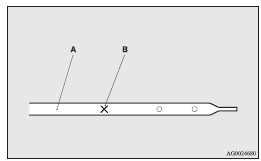To check and refill engine oil
1600 models

1800 models (petrol-powered vehicles)

1800 models (diesel-powered vehicles)

2000 models

The engine oil used has a significant effect on the engine’s performance, service life and startability.
Be sure to use oil of the recommended quality and appropriate viscosity.
All engines consume a certain amount of oil during normal operation. Therefore, it is important to check the oil level at regular intervals or before starting a long trip.
1. Park the car on a horizontal surface.
2. Switch off the engine.
3. Wait a few minutes.
4. Remove the dipstick and wipe it with a clean cloth.
5. Reinsert the dipstick as far as it goes.
6. Remove the dipstick and read the oil level, which should always be within
the range indicated.
7. If the oil level is below the specified limit, remove the cap located on the
cylinder head cover and add enough oil to raise the level to within the specified
range. Do not overfill to avoid engine damage. Be sure to use the specified engine
oil and do not mix various types of oil.
8. After adding oil, close the cap securely.
9. Confirm the oil level by repeating step 4 to 6.
Use only the recommended oils with an ACEA, API or JASO classification as specified in this manual.
![]() Caution
Caution
► In diesel-powered vehicles, when burning away and removing soot accumulated
in the DPF, fuel can mix with the engine oil and an increase in the engine oil level
may occur. This does not indicate an abnormality.
However, if the engine oil level is at or over the “X” mark (B) on the engine oil
dipstick (A), change the engine oil.

![]() Note
Note
► On vehicles equipped with turbocharger, the engine oil consumption is greatly
influenced by payload, engine speed, etc. Depending on how you drive, it can reach
1.0 lit./1,000 km.
► The engine oil will deteriorate rapidly if the vehicle is subjected to severe
conditions, requiring earlier oil replacement.
Please refer to the maintenance schedule.
► For information on how to dispose of used engine oil, refer to page 05.
See also:
Horn switch
When the ignition switch is in the “ON” or “ACC” position, pressing the “”
mark on the steering wheel, causes the horn to sound. ...
Setting of door and rear hatch unlock function (vehicles equipped with the central
door lock switch)
The door and rear hatch unlock function can be set to the following two conditions.
Each time the door and rear hatch unlock function is set, a chime will sound
to tell you the condition of the doo ...
If the vehicle breaks down
If the vehicle breaks down on the road, move it to the shoulder and use the hazard
warning flashers.
If the engine stops/fails
Vehicle operation and control are affected if the engine stops. Befor ...
